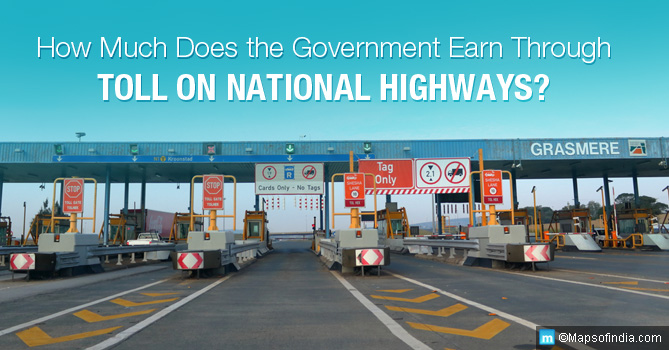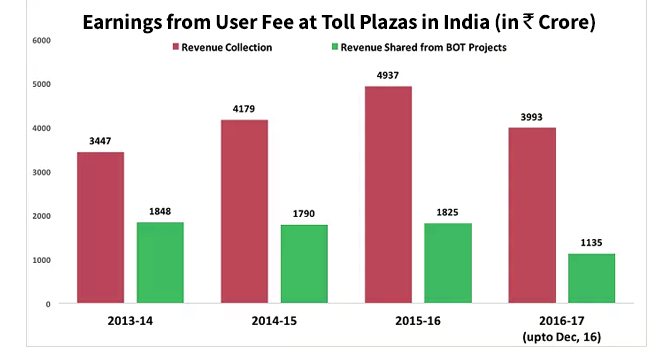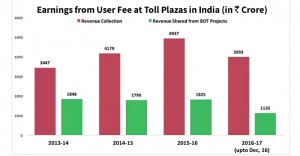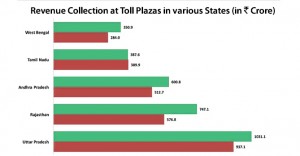 Highway construction and maintenance is an important component of the government’s overall plan to boost infrastructure spending and development.
Highway construction and maintenance is an important component of the government’s overall plan to boost infrastructure spending and development.
National Highways Authority of India (NHAI) has been the nodal agency tasked with developing national highways and appointing concessionaires for building highways under the Build, Operate and Transfer (BOT) basis.
National highways cover just 2% of the total road network in the country, but account for 40% of total traffic, and therefore, its contribution to the Indian economy is significant. The national highways network covers 1,00,087 km, as on January 2017.
Revenue Collection from Toll Plazas Needs a Closer Look
There are 394 Toll Plazas at various points on national highways, as of November 2016, and till December 31, 2016, the total revenue collected was Rs 5,128 crore. Of this, Rs 3,993 crore was the revenue collection (non-BOT) and Rs 1,135 crore was BOT-shared.
A quick glance at annual revenue collection between 2013 and 2016 reveals a steady growth; however, the revenue collection from BOT projects has remained more or less the same. This is a matter of concern, as the traffic on highways has significantly grown since 2013 and is borne out by the increase in LCVs and MHCVs being introduced annually. The same lies true for passenger cars.
Why Have the BOT-based Revenues Not Shown Proportionate Growth?
It is true that highways development under BOT has been languishing since 2012, with most private road developers suffering losses on various accounts including hurdles in land acquisition, local protests, lack of timely credit release and increasing cost of construction, all of which have impacted their performance.
But where roads have been completed and toll plazas fully operational, BOT operators will need to explain the lack of revenue growth especially since non-BOT projects have shown steady increase in revenue since 2013.
The mismanagement of the toll plaza at Gurgaon is a case in point. Initial estimates of traffic growth, post construction, were underestimated to keep payout to the government at a minimal. The break-even prediction was longer than what was actually achieved, thereby causing loss to the government but increasing profits for the toll operator.
In other places, local vested interests along with political leaders forcefully intervening have also been contributing to revenue losses from time to time. But this still does not justify the lack of revenue growth. So, while the overall collections have been increasing, the revenue to the government has not grown. Management of toll plazas need to be scrutinised closely by the government.
Lack of Safety and Poor Maintenance of Highways Impacting Life and Economy
The government needs to seriously review the existing policies for highway maintenance and toll management. Private operators have been repeatedly guilty of not investing adequately on road repair and maintenance despite revenues and traffic steadily increasing.
The highways remain prone to accidents at several points due to lack of proper signages, timely road repairs and lack of medical facilities to address trauma patients of accidents.
The Yamuna Expressway between Greater Noida and Agra, and Mumbai-Pune Expressway, are good examples of this. Both highways are prone to frequent accidents due to lack of speed control measures, lack of adequate road safety signages and lack of adequate policing to control rogue elements.
Government Moving in the Right Direction
The Minister of Road Transport and Highways, Nitin Gadkari, has recently announced revision in policies to extend responsibility of private developers in road safety and repairs in the post-construction period.
The government has also revised the earlier BOT norms by ensuring that 80% of the land acquisition has been completed before inviting tenders for highway construction. This, along with the fact that operators can exit the project after three years of road completion, is also a positive move towards making the BOT model attractive and viable for private developers.
As of January 2017, NHAI had 48,589 kms of highways under development, of which 25,641 kms had already been extended to four and six lanes; 9,575 kms was under implementation; 233 kms under contract implementation; and 13,373 kms to be awarded.
Let’s hope that revenue collections continue the upward trend along with safety and road maintenance.







